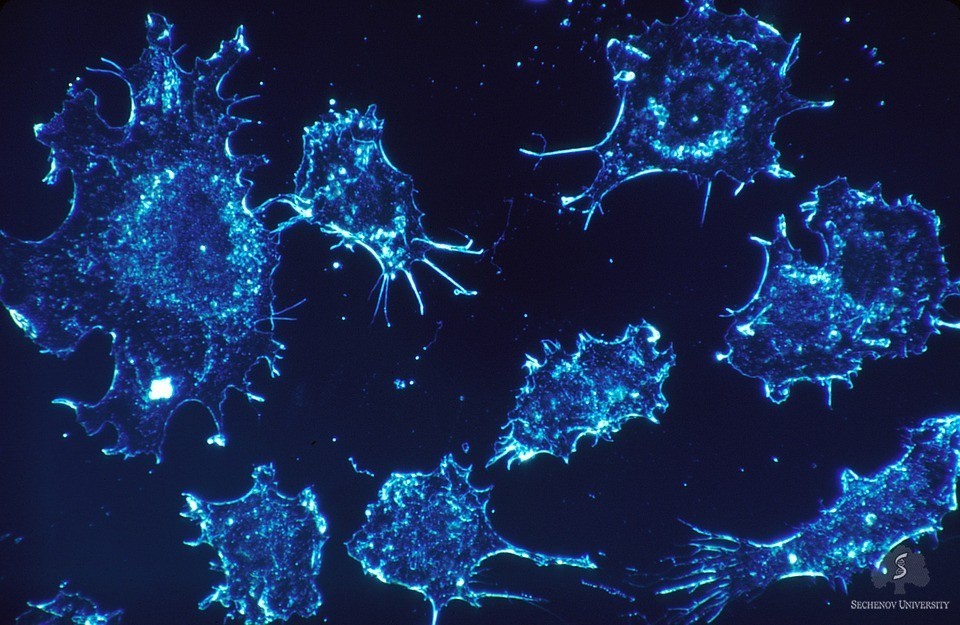-
About University
- Mission & Brand Strategy
- University Leadership
- Rector's Welcome
- History
- Regulatory Documents
- Contacts
- Staff
- International Recruitment
- Partners
Applicants- Why Sechenov University
- Degree Programmes in English
- Preparatory Training
- Non-Degree Programmes
- Transfer from other Institutions
- FAQs
15.07.2020Sechenov researchers analyse cancer drug to personalise prescription
 Effect of ramucirumab may be linked to different gene expression in patients.
Effect of ramucirumab may be linked to different gene expression in patients.
Scientists from Sechenov University and their colleagues from several other organisations in Moscow performed an RNA sequencing study of the samples from patients who suffered from advanced stomach cancer. The results have been published in Cold Spring Harbor Molecular Case Studies.
Gastric tumours are among the deadliest types of cancer, and often they cannot be diagnosed at an early stage. Late diagnosis makes the treatment difficult, and the prognosis may be negative. However, a lot of effort is being made to improve the outcome for such patients, and one of the strategies is to develop antibodies that can be administered directly into the bloodstream. One of such medications is ramucirumab, the only drug offered to patients with advanced gastric cancer after the first-line treatment (chemotherapy) has not worked.
In some people, the effect of ramucirumab is not as strong as expected, and scientists have been trying to figure out why. This can help personalise the prescription to improve the outcome. In order to address the problem, Sechenov scientists decided to extract RNA from patient tumours and analyse its profile.
While the primary function of the DNA is to carry genetic information, RNA plays various roles, depending on its type, size, structure, and origin. Messenger RNA (mRNA) is the product of gene expression — the process when the genes of the DNA are transcribed (i.e. enzymatically copied) into RNA molecules, based on the DNA template. After transcription, the cells use this pool of mRNAs. Roughly speaking, the activity of a gene, or how strong its expression is, can be described by how much mRNA it has produced.
Sechenov researchers analysed RNA profiles from 15 patients with advanced gastric cancer, whose response to ramucirumab treatment varied between 30% and 80%, and found that 3 genes were expressed differently in the tumours of the responders and non-responders. This discovery can shed light on the role of these genes in ramucirumab functioning. The purpose of the drug is to slow down tumour angiogenesis — as a result, the tumour cannot get more blood supply from other tissues and organs. Ramucirumab efficacy varies greatly in different people, and understanding what other genes have to do with it will help customise drug prescriptions to improve the outcome for all patients.
Photo Credit: Pixabay 541954
Embed on website
Sechenov researchers analyse cancer drug to personalise prescription
Effect of ramucirumab may be linked to different gene expression in patients.
Scientists from Sechenov University and their colleagues from several other organisations in Moscow performed an RNA sequencing study of the samples from patients who suffered from advanced stomach cancer. The results have been published in Cold Spring Harbor Molecular Case Studies.
Gastric tumours are among the deadliest types of cancer, and often they cannot be diagnosed at an early stage. Late diagnosis makes the treatment difficult, and the prognosis may be negative. However, a lot of effort is being made to improve the outcome for such patients, and one of the strategies is to develop antibodies that can be administered directly into the bloodstream. One of such medications is ramucirumab, the only drug offered to patients with advanced gastric cancer after the first-line treatment (chemotherapy) has not worked.
In some people, the effect of ramucirumab is not as strong as expected, and scientists have been trying to figure out why. This can help personalise the prescription to improve the outcome. In order to address the problem, Sechenov scientists decided to extract RNA from patient tumours and analyse its profile.
While the primary function of the DNA is to carry genetic information, RNA plays various roles, depending on its type, size, structure, and origin. Messenger RNA (mRNA) is the product of gene expression — the process when the genes of the DNA are transcribed (i.e. enzymatically copied) into RNA molecules, based on the DNA template. After transcription, the cells use this pool of mRNAs. Roughly speaking, the activity of a gene, or how strong its expression is, can be described by how much mRNA it has produced.
Sechenov researchers analysed RNA profiles from 15 patients with advanced gastric cancer, whose response to ramucirumab treatment varied between 30% and 80%, and found that 3 genes were expressed differently in the tumours of the responders and non-responders. This discovery can shed light on the role of these genes in ramucirumab functioning. The purpose of the drug is to slow down tumour angiogenesis — as a result, the tumour cannot get more blood supply from other tissues and organs. Ramucirumab efficacy varies greatly in different people, and understanding what other genes have to do with it will help customise drug prescriptions to improve the outcome for all patients.
Photo Credit: Pixabay 541954



